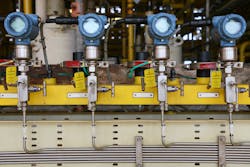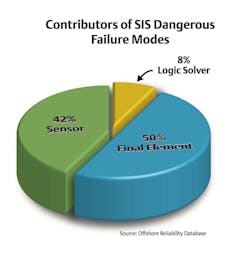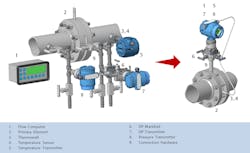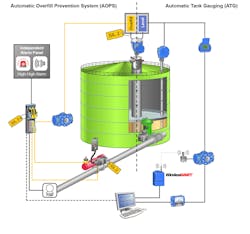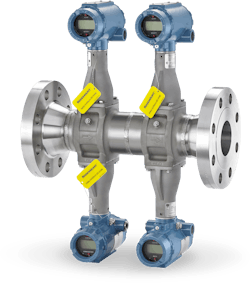Improve the reliability of safety instrumented systems with advanced measurement technologies
According to Reuters, unexpected refining outages have soared in recent years, surpassing 2,000 incidents in 2019, quadruple 2015 levels, according to Industrial Info Resources, a provider of industrial process and energy market intelligence. Insurance rates for property damage and business interruption have increased as much as 100% for some refiners, resulting in energy companies purchasing less coverage than in the past. Although safety has always been the top priority, refineries and chemical plants are looking at additional automation investments to further ensure process and personnel safety to mitigate incidents, as the cost of incidents is on the rise. Upgrading legacy safety instrumented systems (SIS) is often a starting place for improving safety and adapting new digital practices and technologies to increase safety coverage and mitigate risk in the field.
Improving safety with new technologies and digital practices makes sense
Improving measurement sensor reliability
One of the challenges with SIS measurements comes from traditional flow measurement technologies like differential pressure (DP) orifice flowmeters. First, significant maintenance is required to maintain traditional flow measurement technologies like DP orifice flowmeters due to many leak points or freezing/plugging of impulse lines that would result in false readings or trips. Advancements that have been made focus on improving the robustness of these sensors. One of the advancements includes the use of more integrated DP orifice flowmeters. Traditional orifice meters involve multiple connection hardware, pipe penetrations and impulse lines. Figure 2 shows the number of leak points and separate components involved to make a traditional differential pressure flow measurement. Integrated flowmeters are more robust and have multivariable transmitters that reduce the number of leak points, welds and components compared to traditional installations by 80%. These meters provide more reliable measurements while reducing complexity and maintenance.
Another advancement, compact conditioned orifice plates in integral meters, can easily retrofit into existing piping and replace traditional installations, as upstream and downstream straight run piping requirements can be reduced by 90%.
Alternatively, vortex flowmeters have become an increasingly popular technology displacing traditional DP technologies for general process and utility flow measurements. These newly designed vortex flowmeters provide high reliability with an integral design, resulting in no leak points, ports, gaskets or impulse lines. Some vortex flowmeters also have sensors that can be removed online without having to shut down the process in the uncommon event of a sensor failure. Vortex flowmeters are often used in safety applications and steam applications due to few leak points. They also require reduced maintenance in applications where impulse line plugging or maintain heat tracing is needed due to climate conditions or process fluid properties. Furthermore, newer designed vortex meters no longer require flow computers for steam compensation calculations, making installation simpler.
Improving measurement sensor redundancy
Another area of improvement for SIS is implementing measurement redundancy. Lack of redundancy is common due to the investment cost of having multiple instruments or limited installation space. As a result, these systems often had a common source of failure. For example, one primary element or orifice plate would be linked to multiple transmitters. Though the electronics have redundancy, an issue with the primary element would not be detected since there is no redundancy for the sensor. Newly designed technologies have accounted for implementing multiple sensors and electronics in a more cost-effective, single device configuration, reducing installation and capital costs for a variety of measurements such as level and flow.
For example, in tank gauging applications, level measurements are important not only for custody transfer and inventory measurement but also tank overfill protection. Multiple radar gauges are often needed to obtain level measurements for the basic process control for automatic tank gauging and for the SIS automatic overfill prevention system (AOPS). One recent advancement provides a unique 2-in-1 radar level solution for safety upgrades of existing tanks with minimum modification. The innovative 2-in-1 feature includes two radar level gauges in one housing for independent level and overfill measurement compliant to API 2350 and IEC 61511 compliant solutions for automatic and manual overfill prevention systems.
A recent success story involved using these meters at a Chinese petrochemical facility where process trips were reduced by implementing Dual Vortex flowmeters. The plant was using a DP flowmeter to measure steam and feedstock to the cracker. Coke fines would plug the impulse lines and resulted in unreliable measurements, making it difficult to control the steam to hydrocarbon ratio and temperature, resulting in unit trips. The facility replaced 52 traditional DP orifice meters with 52 Dual Vortex Flowmeters, satisfying SIL-3 proven in use rating. The result was reduced unit trips and maintenance by eliminating impulse lines. This improved control of their steam-to-hydrocarbon ratio, resulting in $300,000 savings in decoking.
Early diagnosing of sensor or process issues
SIS failures and trips can occur because of false readings, transmitter failures and sensor failures as these legacy technologies do not have diagnostic capabilities and software solutions that allow early detection with the sensor integrity or even in the process pre-failure. Leveraging advanced diagnostics in pressure, flow, temperature or level devices provides early detection and quick identification of process or device issues that result in equipment failures or inaccurate readings. These diagnostics can reduce planned maintenance and improve personnel safety by decreasing unplanned failures and shutdowns.
Advanced pressure transmitter diagnostics
Some pressure transmitters have comprehensive diagnostics that go beyond the transmitter to cover both the process and electrical loop, enabling early detection of issues. Loop integrity diagnostics can detect issues such as water in the terminal compartment, wiring and grounding issues, corroded terminals and unstable power supply. Safety certified diagnostics for the pressure transmitter can be used to detect internal transmitter failures as well as previously undetectable process and electrical loop failures, reducing the safety instrumented function probability of failure on demand. Process connections such as plugged impulse lines, which is a common source of failure and maintenance, can be detected early through diagnostics as well. Beyond ensuring sensor and electronics reliability, diagnostics can also be used to ensure process safety. The process intelligence diagnostics of the transmitter can track process standard deviation, mean and coefficient of variation to detect changes in process noise early by sampling at 22 times per second. The process intelligence diagnostics have been used to detect abnormal process conditions such as column flooding, cavitation, burner flame instability, agitation loss, entrained air and process leak detection.
A North American refinery used these process intelligence diagnostics in the pressure transmitter to reduce shutdown risk. For the ultra-low NOx emission design required by regulations, the burners run very lean and are on the verge of flame-out, making an early flame-out detection system a requirement to prevent a unit shutdown. Two solutions were tried that did not work. The refinery then decided to implement the pressure transmitter advance diagnostics to measure the amplitude of the process noise by sampling at 22 times per second and to measure a secondary variable, standard deviation, for early detection of flame instability. The advanced diagnostics provided a viable means of reducing the risk of low NOx burner flame-out and preventing heater shutdowns.
Advanced temperature transmitter diagnostics
Unexpected failure of temperature measurement can cause safety concerns or process shutdowns. Advanced diagnostics can be used to monitor processes to identify sensor failures and intermittent or abnormal sensor conditions to proactively protect assets. In particular, a hot backup capability prevents loss of measurement signal when the primary sensor does fail by automatically switching to the backup secondary sensor and sends an alert notification that the primary has failed. Advanced diagnostics include configurable process alerts — a feature that allows alarm level customization based on application requirements. The measurement validation diagnostic enables distinguishing valid measurement data from false readings, preventing erroneous readings from causing unnecessary downtime. Other diagnostic capabilities include thermocouple degradation, open/short sensor diagnostic, sensor drift alert and diagnostics related to voltages. These advanced transmitters are often used in critical safety loops, such as controlling reactor temperatures to prevent temperature excursions.
Advanced flowmeter diagnostics
Smart Meter Verification is an advanced online diagnostic tool for Coriolis and magnetic meters. Traditionally, to verify meter health, detect problems and performance, meters would have to be pulled offline to inspect and send for calibration at regular intervals or problems were only detected when an incident occurred. Smart Meter Verification is an on-demand tool that automatically verifies meter performance without having to pull meters offline. For example, Smart Meter Verification of Coriolis meters detects problems like corrosion, erosion, two-phase flow and abnormal flow ranges earlier to mitigate meter damage or measurement accuracy. The Smart Meter Verification diagnostic can extend full proof-test intervals by providing 91% coverage of undetected dangerous failures in-situ. A large global chemical manufacturer captured these benefits by leveraging Smart Meter Verification for Coriolis meters to improve safety by eliminating human factors and loss of SIS measurement function during proof-testing. Traditionally, proof-testing would involve taking the meter out of service and bringing it to a calibration facility; now inline verification of meter accuracy can be done in-situ, improving both process and personnel safety.
Advanced diagnostics and software level solutions for proof-testing
Regular proof-testing is an essential requirement for SIS in liquid level measurement applications, as it ensures that they are operating to the necessary safety integrity level (SIL). Traditionally, proof-testing has been performed with multiple technicians in the field and one in the control room, verifying the safety system reaction. This requires a considerable amount of time and effort, can pose safety risks to workers who need to climb tanks to perform the test, could take the process offline for an extended period, and can be prone to errors.
However, the technological advances of the latest generation of level measurement technologies are now enabling proof-testing to be performed remotely and without interrupting the process, making the procedure much quicker, safer and more efficient.
For the latest vibrating fork level detectors, remote partial proof-testing is performed by issuing a HART command from the control room. Upon receiving the command, the device enters test mode, cycling the output through wet, dry and fault states, then returning to normal operation. Since the test can be performed in-process, it can take less than one minute to complete.
With advanced guided wave radar transmitters, an adjustable verification reflector fitted to the probe is used to simulate a high level in a tank. This avoids the need to fill the tank just to test the instrument and eliminates the risk of a spill if a device fails to activate during testing. To remotely proof-test the latest non-contacting radar level transmitters and gauges, a high-level alarm can be verified using a simulated reference reflector. The proof-testing procedure is simplified through the use of dedicated software, which leads the operator through the various procedures step-by-step and only requires them to input a straightforward sequence of settings and commands.
All of these newer methods save time and money while providing an easier and safer, more digital way for proof-testing with minimal process interruptions, eliminating the need to climb tanks, and extending time between proof-test intervals.
Advancing and digitalizing safety makes sense
Historically, safety has always been a strong investment focus for refineries and chemical plants but will continue to be an ongoing focus area as the insurance coverage costs rise and insurance coverage decreases. With newer and more comprehensive ways to mitigate safety risks, refineries and chemical plants should reevaluate their approach to safety. With newer, more robust and smarter measurement technologies now embedded with advanced diagnostics and digital work practices focused on ensuring measurement reliability for both the sensor and electronics, it makes sense to implement a more holistic approach to protecting and covering the safety of personnel and assets.
References:
Meha Jha is a refining industry marketing manager for Emerson. Since joining Emerson, she was selected for Emerson’s Engineers in Leadership Program, where she broadened her refining expertise by working on projects related to mass balance and utilizing measurement solutions to improve energy efficiency and safety. She earned a Bachelor of Science in chemical engineering from Auburn University.
About the Author
Meha Jha
Meha Jha a refining industry marketing manager for Emerson. Jha holds a bachelor’s degree in chemical engineering from Auburn University. Jha is focused on helping refiners leverage Emerson’s measurement and analytical instrumentation to improve safety, reliability, efficiency and optimization. She was selected for Emerson's Engineers in Leadership Program.
Julie Valentine
Julie Valentine is the director of global refining measurement solutions for Emerson. Valentine holds a bachelor’s degree in chemical and petroleum refining engineering from Colorado School of Mines. She has authored numerous technical papers on various applications of flow technology in the refining industry and is the co-inventor of two U.S. patents for Emerson’s measurement solutions business.
